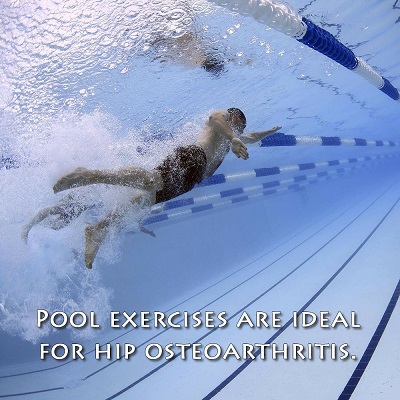 Exercising is probably the last thing on your mind if you have hip pain due to osteoarthritis. After all, physical activities are painful! However, you need to force yourself to move even if you don’t have the motivation, just so you don’t add more problems and discomfort in the future.
Exercising is probably the last thing on your mind if you have hip pain due to osteoarthritis. After all, physical activities are painful! However, you need to force yourself to move even if you don’t have the motivation, just so you don’t add more problems and discomfort in the future.
Lack of exercise can worsen your condition and may lead to muscle atrophy (wasting). So, you need to move around. You can always begin with low impact exercises to improve your mobility, muscle strength, and the stability of your hip joint.
Low Impact Exercises
Low impact exercises are physical activities that increase your heart and respiratory rate without excessive strain on your limbs. Aside from reducing pain, regular low impact exercises will improve your sleep and mood. Engaging in these exercises at least 2 hours per week is a good start.
- Walking – If you’ve been inactive because of hip pain, walking is the first and best exercise you can do at the moment. It’s a low impact exercise that’s effective at soothing pain, swelling, and stiffness in your hip.
- Water-based exercises – Walking in the pool is an excellent form of exercise if you have hip osteoarthritis. Water-based exercises help reduce stress on your joints. You can start with walking in the pool first, and as you improve your muscle strength and flexibility, you can try moderate exercises like swimming.
- Yoga – Another low impact exercise that can help improve your joint function and flexibility is yoga. It’s a gentle form of exercise that can help manage the pain caused by osteoarthritis.
Strengthening Exercises
Engaging in exercises that help strengthen your hips can provide long-term relief from the pain you’re feeling in your hips because of osteoarthritis. You can have physical therapy, but you can also do it yourself at home using simple muscle strengthening exercises at least twice a week.
- Sit to stand – As its name suggests, this exercise involves sitting on a chair and standing up slowly. Repeat this for 30 seconds, and do it a few times daily.
- Mini wall-squats – Perform squats with your back against the wall for support.
- Hip extension – Hold the back of the chair for support. Lift your right leg straight behind you as high as you can while contracting your glutes. Be sure to keep your back and your other leg straight. Repeat on the left leg and do the whole exercise again six times.
- Hip strengthening exercises – you need to have strong core and glute muscles to stabilize your hips and pelvis. You can do this by performing the transverse abdominal brace, glute sets, and bridge exercises.
Range of Motion Exercises
Exercises, such as bringing your knee to your chest while laying down on the floor, can help improve your range of motion. They help improve the flexibility of your joints and your body posture. You can also do leg raises and standing jacks.
- Leg raises – While standing, hold on to a chair with your right hand and slowly raise your left leg in front of you until it’s parallel to the ground. Repeat 10 times and then do it on your left leg.
- Standing jacks – Still in a standing position with your right hand holding on to a chair for support, raise your right leg to the side as high as you can. Repeat 10 times, then switch to your left leg.
Is There Any Exercise You Need to Avoid?
Osteoarthritis in the hip is a painful condition, which is why experts suggest low impact exercises first as you transition from inactivity to activity. Once you get your body used to it, you can move on to strength exercises.
High impact exercises are a big no if you have hip osteoarthritis and you’ve just started doing exercises. You shouldn’t be running or jumping right away because these physical activities could do further damage to your joints. You will certainly experience acute pain, with little benefit.
Once you’ve built up your strength and endurance, you can slowly incorporate strength exercises into your daily routine. But this only applies to mild osteoarthritis. If you have severe osteoarthritis in your hip, you should consult your doctor first. Your health expert will tell you if you should avoid workouts that involve jumping or running and those that require changing direction quickly.
Living with osteoarthritis in the hips isn’t easy, but there are things you can do to soothe the pain and discomfort associated with this condition. As you perform these exercises, don’t forget to listen to your body and adjust your physical activities as necessary. Whether you have mild or severe osteoarthritis, it’s best to talk to your doctor first before doing any rigorous exercises.






